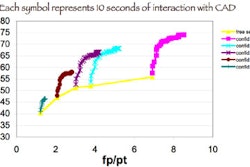MDCT did a little better than MRI in the task of characterizing kidney lesions in a new study by German researchers, but both modalities were only mediocre in differentiating benign from malignant lesions.
The study from Technische Universität München in Germany compared the diagnostic performance of 16-slice multidetector-row CT (MDCT) with that of MRI in characterizing kidney lesions in 28 patients, and examined histology in the 12 who later underwent surgery.
The widespread use of imaging modalities has yielded a large number of renal lesions that require further characterization, wrote Dr. Ambros Beer and colleagues in the June American Journal of Roentgenology (Vol. 186:6, pp. 1639-1650).
"This examination is most often done with CT or MRI, both of which are well-established techniques in the field of renal imaging," they wrote. "Although CT is the preferred technique because of availability, lower cost, and spatial resolution, it is still unclear which method is best suited for renal imaging with state-of-the-art techniques," inasmuch as previous studies used single- or four-slice detector-row CT.
Because surgeons base their decision of whether to operate or treat conservatively based mainly on imaging results, the question of whether to operate took precedence.
"The primary goal of this study was to evaluate the diagnostic performance of state-of-the-art MDCT and MRI for differentiation of surgical from nonsurgical kidney lesions," the team wrote.
The study included 28 patients (eight women, 20 men; ages 27-84, mean age 64.8 ± 13.9 years) with kidney lesions detected on sonography that required further evaluation. Patients with lesions well characterized on US were excluded, as were those with contraindications to CT, and MRI and CT were performed within three weeks.
Triphasic CT imaging was performed on a Somatom Sensation 16 scanner (Siemens Medical Solutions, Malvern, PA) and included unenhanced, arterial, and portal venous phases at 16 x 0.75 mm, 120 kVp, and 200 mAs (CareDose mode). Contrast media consisted of 20 mL to enhance the renal pelvis and ureters, followed by 120 mL of iomeprol (Imeron 300, Altana Pharmaceuticals, Konstanz, Germany) at 4-5 mL/sec and a saline flush.
Oral contrast (meglumine ioxithalamate) was also used in 20 cases in which malignancy was strongly suspected. Each phase was reconstructed with a 4-mm slice thickness and 4-mm reconstruction increment and viewed on a Siemens Leonardo workstation, according to the authors.
MRI images were acquired on a 1.5-tesla superconducting imaging system (Gyroscan Intera, Philips Medical Systems, Andover, MA) equipped with a high-performance gradient system and a phased-array surface coil. The team acquired a T2-weighted fast spin-echo sequence (TR/TE 2,200/120) axially with spectral presaturation by inversion recovery and 6-mm slice thickness.
Next T1-weighted unenhanced fast spin-echo sequences (TR/TE 500/15) were acquired; followed in the coronal plane by a dynamic gadolinium-enhanced T1-weighted 2D gradient-echo sequence (TR/TE 233/5.6; flip angle 80º), using 5-mm slice thickness at 0, 20, 50, and 160 seconds after administration of gadopentetate dimeglumine (Magnevist, Schering, Berlin) at 0.1 mmol/kg body weight IV at 2 mL/sec. The T1 images were repeated after gadolinium administration.
Two experienced radiologists read the images in consensus without knowledge of clinical or histologic data on the workstation, with MRI and CT images separated by at least eight weeks' time, Beer and colleagues wrote.
Image quality was rated on a four-point scale, and the radiologists classified lesions as surgical or nonsurgical with 5 levels of confidence, with the requirement of a definite diagnosis for each lesion.
"The image quality of MDCT (mean grade 2.79 on a 0-3 scale) was superior to that of MRI (1.93; p < 0.01)," the authors wrote.
The mean image grade for all CT scans was 2.79 ± 0.42, while for MRI the mean image quality was 1.93 ± 0.60, and the difference between the two modalities was statistically significant (p < 0.001). ROC analysis showed no statistical difference between the performances of the two modalities for differentiating surgical from nonsurgical kidney lesions.
"The area under the curve for differentiating surgical from nonsurgical lesions was 0.979 for MDCT and 0.957 for MRI with resulting sensitivity and specificity values of 92.3% and 96.3% for MDCT, and 92.3% and 91.3% for MRI," they wrote.
Sensitivity and specificity values for definite classification of the lesions were 93.8% and 68.4% for MDCT and 93.8% and 71.4% for MRI, the authors wrote. Reviewer confidence was also equivalent for both modalities with an optimal cutoff at a confidence level of 4.
All images were of diagnostic quality, although six MRI images were considered poor-quality with many artifacts, and none of CT images were of poor quality.
"Both techniques were very good in detection of malignant renal lesions, and the probability of misclassifying a malignant lesion as benign is low," they wrote. "Many lesions managed surgically, however, turned out to be benign after the operation. Although this result may have been due in part to the large number of oncocytomas in our study (two patients with nine oncocytomas), it reflects a common problem in renal imaging: Solid enhancing lesions (without fat) must be considered surgical lesions, because no definite imaging criteria exist for differentiating carcinomas from adenomas and oncocytomas."
Both 16-slice MDCT and MRI are excellent modalities for differentiating surgical from nonsurgical renal lesions detected with sonography, the authors concluded. Still, they added, "neither technique can be used to further differentiate benign from malignant tumors in cases of solid enhancing lesions without fat."
Because it is cheaper, faster, and more widely available, MDCT continues to be the preferred technique for further evaluating such lesions, especially when malignancy is strongly suspected, they wrote. However, they added, MRI is a useful alternative in cases of contrast contraindication, or when CT's radiation dose is an issue.
By Eric Barnes
AuntMinnie.com staff writer
June 20, 2006
Related Reading
CT for suspected kidney stones often uncovers other findings, June 5, 2006
Image-guided biopsy may help avoid nephrectomy, May 4, 2006
Image guidance evolves into imaging therapy, May 12, 2006
Hemofiltration prevents contrast-induced nephropathy, March 8, 2006
Part II: Palliative steps prevent contrast-induced nephropathy, September 20, 2005
Copyright © 2006 AuntMinnie.com




















